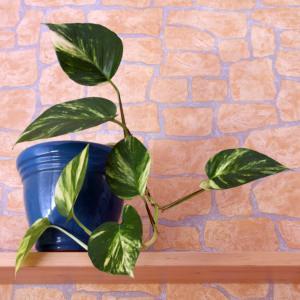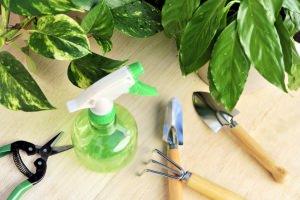Pothos
Post from EditorialsNice to look at and easy to care for: Pothos is one of the most popular evergreen plants in our houses. Here are some suggestions to take care of your plant.
A few years ago, due to a period that I was forced to stay at home, I discovered an unexpected  passion towards plants: those who stood by me at the time, rightly thinking of something to please me, started giving me as a gift all kinds of plants, some of which were very delicate.
passion towards plants: those who stood by me at the time, rightly thinking of something to please me, started giving me as a gift all kinds of plants, some of which were very delicate.
To my great regret, however, the latter shortly afterwards died: I was too inexperienced to take care of them, so I looked for a plant that did not require too much attention, but that was beautiful and vital. I chose the Pothos, a hanging plant that, in my opinion, really manages to furnish its corner: here are some tips to take care of it at the fullest.
Origins and characteristics of Pothos
It is quite difficult that you do not know this evergreen broad leaves plant with a deep green color, sometimes streaked with white or yellow: the most common type - there are about forty varieties - it's called Scindapsus, belonging to the family Araceae, it comes from the Solomon Islands, located in the Pacific Ocean, east of Papua New Guinea.
It 'an evergreen plant, so no flowering but, as anticipated, gives, if healthy, beautiful green leaves - that vaguely resemble those of ivy, just bigger - able to create an effective ornamental effect.
Lighting and habitats
 As we can gather from the origins of the plant, it is used to a tropical climate: the ideal temperature, is between 13° and 27°C. The corner of your house, where you will place the Pothos should be bright but avoiding the direct exposure to the sun: a sign of the health of the plant will be the presence of streaks we mentioned previously.
As we can gather from the origins of the plant, it is used to a tropical climate: the ideal temperature, is between 13° and 27°C. The corner of your house, where you will place the Pothos should be bright but avoiding the direct exposure to the sun: a sign of the health of the plant will be the presence of streaks we mentioned previously.
If you don't see any, it means that the plant is not sufficiently illuminated: it will be necessary, therefore, to move it. The plant suffers from low temperatures in winter, therefore, make sure that your Pothos is affected as little as possible and avoid placing it near the windows.
Watering
If you value your plant, do not water it all the time, especially during winter: you risk a sudden yellowing of leaves from their peak, a sign that the  Pothos has received more water than necessary. The ideal solution is to atomize the water, using the proper squirting bottle only when you realize that the top layer of soil begins to be too dry: it is important to do this also on the leaves.
Pothos has received more water than necessary. The ideal solution is to atomize the water, using the proper squirting bottle only when you realize that the top layer of soil begins to be too dry: it is important to do this also on the leaves.
Obviously, during the summer it will be necessary to intensify the nebulizations. It would be appropriate to accommodate the expanded clay granules between the pot and its saucer: the water in the clay, evaporating, will provide the right level of moisture to the plant.
Soil, repotting and fertilizing
The roots of your Pothos begin to peep out of the jar? It 'obviously time to repot the plant: you can do this using a soil composed of one part of sand and two of peat to be placed in pots preferably earthenware. In fact, they allow the water in excess to evaporate and give way to the roots to breathe.
time to repot the plant: you can do this using a soil composed of one part of sand and two of peat to be placed in pots preferably earthenware. In fact, they allow the water in excess to evaporate and give way to the roots to breathe.
As for the fertilizing, use products that possess a high content of nitrogen that stimulates the development of the green parts: it would be appropriate to feed the plant once a month by diluting the fertilizer in the water to use for watering in very small quantities, however, take by reference what is indicated on the packaging.
Multiplication of Pothos
 Pothos is one of the plants whose propagation almost always gives excellent results: it usually happens by cuttings. Basically, there are two most popular methods: the first, perhaps is the most well known, to fix the apical cuttings in a container filled with water. A cute idea to give the kitchen or living room an English cottage effect, is to use the classic American coffee mugs - the mug, so to speak - to contain water and cuttings once the roots are formed you can arrange to place the plant in a vase. This can be done at any time of year.
Pothos is one of the plants whose propagation almost always gives excellent results: it usually happens by cuttings. Basically, there are two most popular methods: the first, perhaps is the most well known, to fix the apical cuttings in a container filled with water. A cute idea to give the kitchen or living room an English cottage effect, is to use the classic American coffee mugs - the mug, so to speak - to contain water and cuttings once the roots are formed you can arrange to place the plant in a vase. This can be done at any time of year.
If you prefer, in the spring you can ensure that the cutting genres the roots by placing it in a jar that you have previously filled with two parts of peat and one of sand: hold the plant with an iron yarn, cover it with a plastic bag and place it in a corner where it is not directly illuminated and in which the temperature is around 20°C. As soon as the shoots appear, it will be possible to give a definitive placing to your plant: in the meantime, remember to regularly open the bag to eliminate condensation.
80838 REGISTERED USERS










